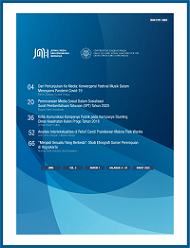Shared Identity and Trust Among the Furry Fandom: A Narrative Review
Rifqi Zuhdi Amarta(1*), Dilah Ratna Kartika(2)
(1) Universitas Gadjah Mada
(2) Universitas Pendidikan Indonesia
(*) Corresponding Author
Abstract
Shared identity has played a major role in the formation of fandom in the digital age, where online interaction became the dominating mode of social interaction among individuals. The Furry fandom's online ingroup interactions are examined through the evolving process of identity and trust development, highlighting the role of virtual platforms in fostering community cohesion. This paper reviews previous literature about Furry fandom from four aspects of Social Exchange Theory (SET), namely trust, commitment, reciprocity, and power. The narrative review method is employed to explore how these aspects contribute to the resilience of shared identity and trusts within the Furry fandom. The review conducted on six scholarly articles surrounding the theme of Furry ingroup interaction underlined a common belief in how individuals who identify as Furry share a common sense of identity, which fosters a sense of trust and camaraderie within the community. This shared identity serves as a foundation for a sustainable ingroup trust and contributes to the overall cohesion of the furry fandom. This paper suggests that future research could adopt a more in-depth analysis on the importance of trust and its sustainment within ingroup interaction in the scope of the digital age.
Keywords
Full Text:
PDF_4References
Blau, P. M. (1964). Exchange and Power in Social Life. New York: Wiley.
Bruckner, B. K. (2016). Organisationales Vertrauen initiieren. Springer Fachmedien Wiesbaden.
Cook, K. S., Cheshire, C., Rice, E. R., & Nakagawa, S. (2013). Social exchange theory. Handbook of social psychology, 61-88.
Dixon-Woods, M., Agarwal, S., Jones, D., Young, B., & Sutton, A. (2005). Synthesising qualitative and quantitative evidence: a review of possible methods. Journal of health services research & policy, 10(1), 45-53.
Emerson, R. M. (1976). Social Exchange Theory. Annual Review of Sociology, 2, 335-362. Retrieved from http://www.jstor.org/stable/2946096
Finuras, P. (2023). Social Identity and Trust: An Evolutionary Perspective. Journal of Intercultural Management and Ethics, 6(3), 5-17.
Gray, J., Sandvoss, C., & Harrington, C. L. (2007). Introduction: Why Study Fans? In Fandom: Identities and Communities in A Mediated World (pp. 1–16). New York University Press.
He, H., Li, X., Tavsel, M., & Zhou, R. (2022). A Literature Review on Fans’ Identity Construction. Adavances in Social Science, Education and Humanities Research, 638, 419–423.
Heinz, M. (2020). “There’s A Little Bit of That Magic Where I’m Becoming Something Else”: LGBT+ Furry Identity Formation and Belonging Online. Journal for Undergraduate Ethnography, 10(2), 21-37.
Homans, G. C. (1958). Social behavior as exchange. American journal of sociology, 63(6), 597-606.
Kington, C. S. (2015). Con Culture: A Survey of Fans and Fandom. Journal of Fandom Studies, 3(2), 211–228. https://doi.org/10.1386/jfs.3.2.211_1
Kou, J. (2021, November). Collective Action of the “Fandom Girls” in Fighting the Epidemic——Based on the perspective of social identity theory. In 2021 International Conference on Culture-oriented Science & Technology (ICCST) (pp. 651-655). IEEE.
Lamerichs, N. (2018). Shared Narratives: Intermediality in Fandom. In Productive Fandom. Amsterdam University Press.
Mock, S. E., Plante, C. N., Reysen, S., & Gerbasi, K. C. (2013). Deeper leisure involvement as a coping resource in a stigmatized leisure context. Leisure/Loisir, 37(2), 111-126.
Neville, F. G., & Reicher, S. D. (2018). Crowds, social identities, and the shaping of everyday social relations. Political psychology: A social psychological approach, 231-252.
Osburg, T., & Heinecke, S. (Eds.). (2019). Media trust in a digital world: Communication at crossroads. Springer Nature.
Peacey, B. (2020). You're the only one who knows my true identity: how fandoms create new identities for constructed language learners (Doctoral dissertation, University of British Columbia).
Plante, C. N., Roberts, S. E., Snider, J. S., Schroy, C., Reysen, S., & Gerbasi, K. (2015). ‘More than skin‐deep’: Biological essentialism in response to a distinctiveness threat in a stigmatized fan community. British Journal of Social Psychology, 54(2), 359-370.
Reysen, S., Plante, C. N., Packard, G., Siotos, D., Roberts, S. E., & Gerbasi, K. C. (2023). Acculturation strategies as predictors of fandom identification in the fanfiction, Star Wars fan, and furry communities. The Journal of Social Psychology, 1-13.
Reysen, S., Plante, C. N., Roberts, S. E., & Gerbasi, K. C. (2015). Ingroup bias and ingroup projection in the furry fandom. International Journal of Psychological Studies, 7(4), 49.
Satinsky, E., & Green, D. N. (2016). Negotiating identities in the furry fandom through costuming. Critical Studies in Men’s Fashion, 3(2), 107-123.
Shafirova, L., & Kumpulainen, K. (2021). Online collaboration and identity work in a brony fandom: Constructing a dialogic space in a fan translation project. E-learning and Digital Media, 18(3), 269-289.
Thibaut, J. W., & Kelley, H. H. (1959). The Social Psychology of Groups. Transaction Publishers.
Article Metrics
Refbacks
- There are currently no refbacks.
Copyright (c) 2024 Jurnal Media dan Komunikasi Indonesia

This work is licensed under a Creative Commons Attribution-ShareAlike 4.0 International License.
| Jurnal Media dan Komunikasi Indonesia (Online ISSN 2721-396X) is published by the Department of Communication Science (DIKOM), Faculty of Social Science and Political Science (FISIPOL), Gadjah Mada University |












